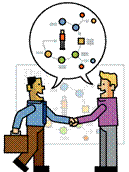
Keep in touch! Sign up to get updates and occasional emails from me.
 A 1997 study found that when people create visual diagrams, they use about 6 to 12 visual elements, or "nodes" to describe a system.
A 1997 study found that when people create visual diagrams, they use about 6 to 12 visual elements, or "nodes" to describe a system.Keep in touch! Sign up to get updates and occasional emails from me.
 Interesting post from ext337:
Interesting post from ext337:Keep in touch! Sign up to get updates and occasional emails from me.
 Do you remember the last time you underwent a transformation?
Do you remember the last time you underwent a transformation?Keep in touch! Sign up to get updates and occasional emails from me.
 Sometimes an innocent comment triggers a violent response. Did you stumble on a hot button? Careful! Once a hot button is pressed, it doesn't matter what you say — people need time to cool down.
Sometimes an innocent comment triggers a violent response. Did you stumble on a hot button? Careful! Once a hot button is pressed, it doesn't matter what you say — people need time to cool down.
Keep in touch! Sign up to get updates and occasional emails from me.
 We're talking at each other instead of to each other. Each person seems like they are waiting for their next chance to talk, when they should be listening.
We're talking at each other instead of to each other. Each person seems like they are waiting for their next chance to talk, when they should be listening.
Keep in touch! Sign up to get updates and occasional emails from me.
 Your perspective can impact your ability to see a situation clearly. Try to see the situation from another point of view.
Your perspective can impact your ability to see a situation clearly. Try to see the situation from another point of view.
Keep in touch! Sign up to get updates and occasional emails from me.
 Here are a couple of tips that will help you have better conversations:
Here are a couple of tips that will help you have better conversations:Keep in touch! Sign up to get updates and occasional emails from me.
Keep in touch! Sign up to get updates and occasional emails from me.
 Do you want to see more change in the world? Do you want to see more of your ideas come to fruition? To see them become adopted by others and thrive?
Do you want to see more change in the world? Do you want to see more of your ideas come to fruition? To see them become adopted by others and thrive?Keep in touch! Sign up to get updates and occasional emails from me.

Keep in touch! Sign up to get updates and occasional emails from me.
 Heath Row of Squidoo just interviewed me about visual thinking school. Here's a transcript:
Heath Row of Squidoo just interviewed me about visual thinking school. Here's a transcript:Keep in touch! Sign up to get updates and occasional emails from me.
 Embedded devices are the computers you don't see. They're inside more and more things all the time.
Embedded devices are the computers you don't see. They're inside more and more things all the time.Keep in touch! Sign up to get updates and occasional emails from me.
 By Chris Brogan
By Chris BroganKeep in touch! Sign up to get updates and occasional emails from me.

Keep in touch! Sign up to get updates and occasional emails from me.
Keep in touch! Sign up to get updates and occasional emails from me.
 "People rarely become less interesting when they talk less."
"People rarely become less interesting when they talk less."Keep in touch! Sign up to get updates and occasional emails from me.
 Do you live in Seattle?
Do you live in Seattle?Keep in touch! Sign up to get updates and occasional emails from me.